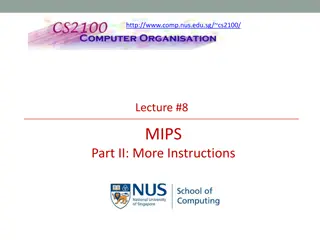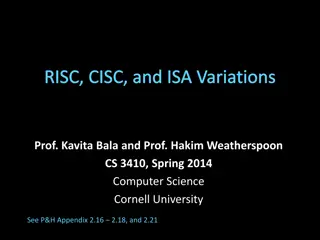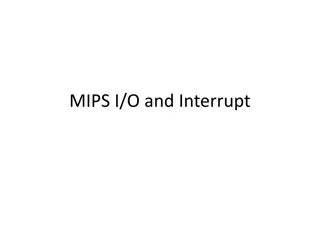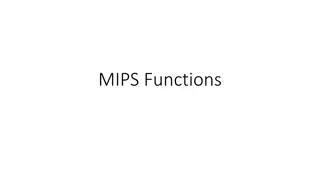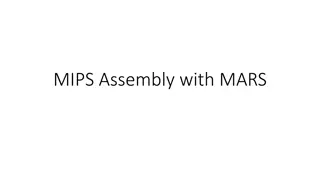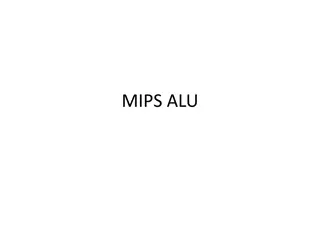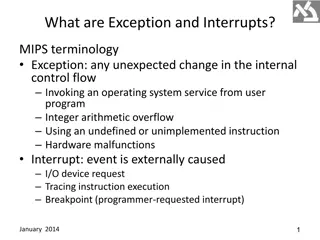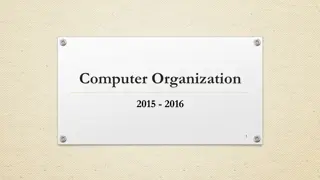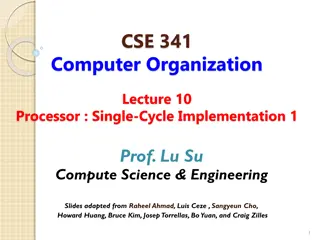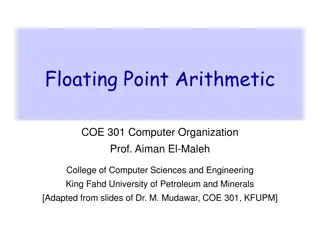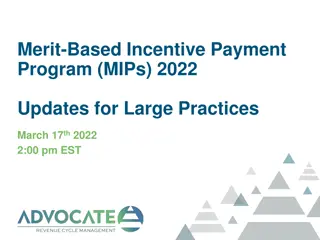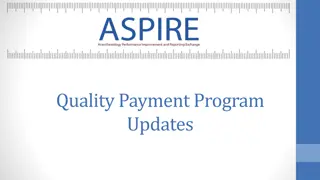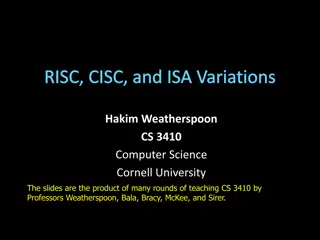Understanding MIPS Part II: Memory Organization and Instructions
Explore the intricacies of Memory Organization in the context of MIPS architecture, covering topics such as Memory Transfer Unit, Word Alignment, Load and Store Instructions, Making Decisions with Conditional Branching and Unconditional Jumps, Loops, Arrays and practical exercises. Learn about the m
16 views • 43 slides
MIPS CPU Design Using Verilog and Instruction Set Architecture Overview
Explore the world of MIPS CPU design using Verilog with a deep dive into Instruction Set Architecture (ISA), SPIM instruction formats, addressing modes, and more. Learn about the key components such as Program Counter (PC), Instruction Memory (IM), Register Files (RF), Arithmetic Logic Unit (ALU), D
1 views • 29 slides
Overview of MIPS Arithmetic and Logic Instructions in COE 301
MIPS Architecture consists of R-Type and I-Type instruction formats for arithmetic, logical, shift, and immediate constant operations. It includes a variety of general-purpose registers and specific units for execution, floating-point operations, and memory handling. The presentation outlines the st
2 views • 29 slides
Understanding Activation Records and Stack in Assembly Programming
Explore the key concepts of activation records and the stack in assembly programming, including their roles in function calls, memory management, and variable storage. Gain insights into the low-level layout of variables, call conventions in MIPS and x86, and practical examples illustrating stack op
2 views • 66 slides
Advanced Techniques for Multiplication Performance Improvement
Explore advanced methods to enhance multiplication performance by utilizing shifts and add/subtract operations instead of traditional arithmetic. The solutions provided involve hexadecimal number pairs, demonstrating the best ways to calculate products efficiently. Furthermore, a challenge is presen
2 views • 59 slides
Performance Analysis of Different MIPS Processors
This analysis compares two different implementations (P1 and P2) of the same instruction set based on clock rates, CPI values, peak performances, and execution times on a 3GHz MIPS processor. The performance trade-offs for changes made to an MIPS process are explored using a breakdown of different p
0 views • 42 slides
MIPS Single-cycle Datapath Analysis for Instruction SW
Examine the operation of the single-cycle datapath for a specific MIPS instruction "SW.R4,-100(R16)". This analysis covers the instruction word value, register numbers, control signals, and the logic diagram implementation. Dive into details like instruction word encoding, register file operations,
0 views • 55 slides
Managing Multiple Priorities Amidst Chaos - Strategies for Success
Effective strategies for managing multiple priorities include maintaining a structured to-do list system, engaging regularly with Most Important Priorities (MIPs), and implementing weekly and daily tactical plans. Avoiding poorly defined tasks and utilizing external systems for tracking commitments
0 views • 29 slides
Understanding Branching and Condition Codes in Computer Architecture
Explore the intricacies of branching statements, if-else statements, condition codes, explicit compare and branch, implicit condition codes, and the use of condition registers in computer architecture. Delve into MIPS architecture's utilization of both implicit and condition registers for efficient
0 views • 16 slides
Understanding RISC, CISC, and ISA Variations in Computer Science
Explore the differences between RISC and CISC architectures, along with variations in Instruction Set Architecture (ISA). Dive into the intricacies of processor design, performance factors, and assembly languages. Get insights into the concepts of control units, memory units, pipelines, and datapath
0 views • 37 slides
Understanding Number Representations and Floating-point Numbers in Computer Science
Exploring the conversion of integers to binary, including the 2's complement method for negative numbers. The concept of fractions in binary and the representation of floating-point numbers in single and double precision formats are also discussed. Special cases like denormalized numbers, infinity,
0 views • 28 slides
Understanding MIPS I/O and Interrupt Handling
Delve into the world of MIPS architecture, exploring how I/O operations and interrupts are managed. Learn about memory organization, system functions, I/O registers, and kernel data. Discover how SPIM facilitates input and output handling, including reading from the keyboard and managing output. Div
0 views • 18 slides
Understanding MIPS Instruction Sets and Binary Execution
This lecture covers the mapping of MIPS instructions to binary for execution, the use of pseudo-instructions to improve code readability, and the handling of large constants. It discusses levels of representation and interpretation, the concept of stored-program computers, addressing in memory, bina
0 views • 50 slides
Understanding MIPS Functions and Calling Conventions
MIPS functions in assembly language are called using the 'jal' instruction, passing arguments in specific registers. Functions must end with 'jr $ra' and have explicit declarations. MIPS functions are stored separately from the main function in memory. The 'jal' instruction jumps to a specified addr
0 views • 18 slides
Understanding Address Translation in Computer Systems
Explore the concept of address translation in computer systems, covering topics such as converting virtual addresses to physical addresses, different translation methods, goals of address translation, bonus features, and a preview of MIPS address translation. Learn about the benefits and limitations
0 views • 60 slides
Introduction to MIPS Assembly Programming with MARS
Introduction to MIPS Assembly Programming with MARS including instructions, I-Type format, register initialization, addi instructions, and translation to machine code using an assembler. Learn how to perform basic arithmetic operations in MIPS assembly language.
0 views • 61 slides
Understanding MACRA and MIPS for Post-Acute Care Providers
Explore the key provisions of MACRA impacting post-acute care (PAC) providers, including the Merit-based Incentive Payment System (MIPS) and Advanced Alternative Payment Models (APMs). Learn about quality reporting requirements, payment structures, and participation options under MACRA to optimize r
0 views • 20 slides
Understanding MIPS Arithmetic Logic Unit (ALU)
The MIPS ALU is the heart of computer calculations, performing functions like add, and, or, and sub. This article delves into designing a full ALU, starting from a 1-bit full adder to a 32-bit ALU. It explores how operations like and, or, and addition are carried out within the ALU, and how to imple
0 views • 28 slides
Exception Handling and Interrupts in MIPS Architectures
Exception and interrupts in MIPS play a crucial role in handling unexpected events and external requests efficiently. Exceptions include changes in control flow, arithmetic overflows, and hardware malfunctions, while interrupts are externally caused events like I/O requests. When an exception occurs
1 views • 29 slides
Understanding Computer Architecture: Exploring MIPs, Assembly Code, and BIOS Functions
Dive into the world of computer architecture with a focus on MIPs assembly language, basic program formats, BIOS functions, and system calls. Learn about the role of the OS kernel, memory addresses, and control flow in executing programs efficiently.
0 views • 16 slides
Understanding Computer Organization and Memory Management
Explore the fundamentals of computer organization, memory organization, and execution of instructions in a processor. Learn about memory addressing, word lengths, byte organization, and access methods. Understand the role of registers in the control path for instruction execution. Delve into MIPS la
0 views • 37 slides
Overview of Single-Cycle Implementation in Computer Organization
Today's lecture discussed the single-cycle implementation of processors, focusing on executing instructions in hardware based on the ISA. The process involves different cycles such as instruction fetch, decode, execution, memory access, and write-back. The presentation highlighted the functions of a
0 views • 24 slides
Understanding Floating-Point Arithmetic in Computer Organization
Exploring floating-point numbers and their representation in the IEEE 754 standard, including addition, subtraction, multiplication, and rounding. Learn about the significance of extra bits, the importance of normalization, and the impact of precision on floating-point values. Delve into MIPS floati
0 views • 74 slides
MIPS 2022 Updates and Program Recap for Large Practices
Explore the latest updates for the Merit-Based Incentive Payment Program (MIPs) in 2022, including performance year changes, quality category considerations, penalty mitigation strategies, and historical thresholds. Learn how MIPS rewards clinicians for high-quality, cost-effective care under MACRA.
0 views • 27 slides
Understanding MACRA and the Quality Payment Program
Explore the impact of the Medicare Access and CHIP Reauthorization Act (MACRA) of 2015 on healthcare providers and services through changes in payment models, penalties, and incentives. Learn about the transition from the Sustainable Growth Rate (SGR) formula, the two pathways of MIPS and Advanced A
1 views • 23 slides
Understanding Context Switching and User-Kernel Interaction in Operating Systems
Context switching in operating systems involves a seamless transition between user-level threads without the kernel's awareness. User-level code manages register state and stack pointers, while user-kernel mode switching requires changing processor privilege levels and agreement on information excha
0 views • 25 slides
Understanding Instruction Set Architectures (ISAs) in Computer Science
Explore the concepts of RISC, CISC, and ISA variations in computer architecture. Dive into the differences between MIPS, ARM, X86, and other ISAs, focusing on load/store, arithmetic, control flow, and more. Gain insights into the evolution and variations of ISAs, and discover the alternatives beyond
0 views • 37 slides
